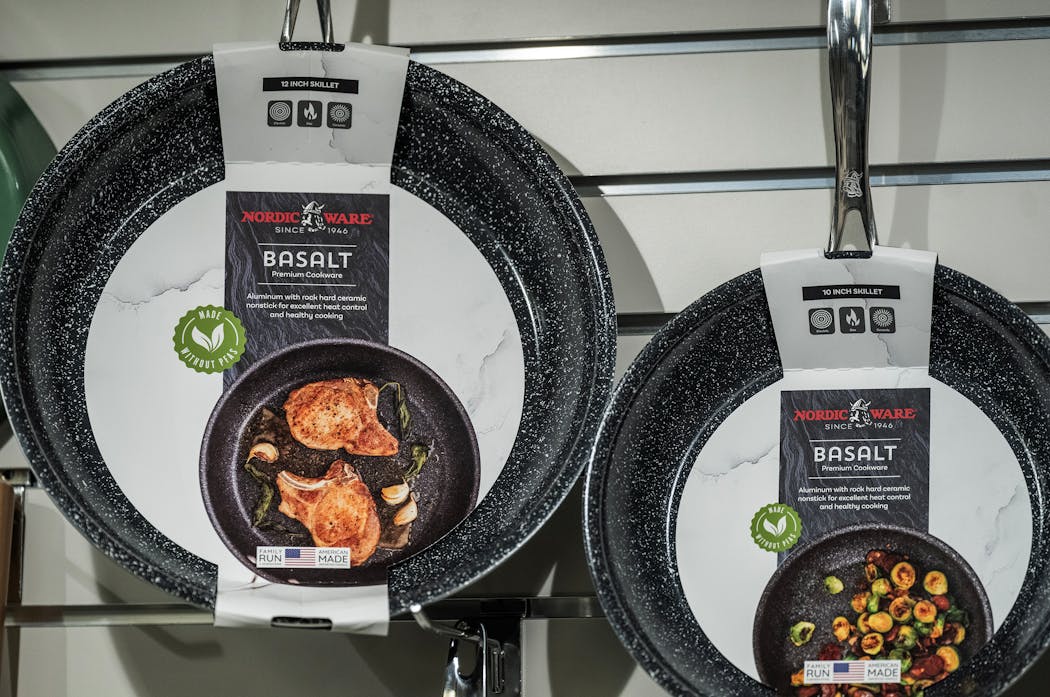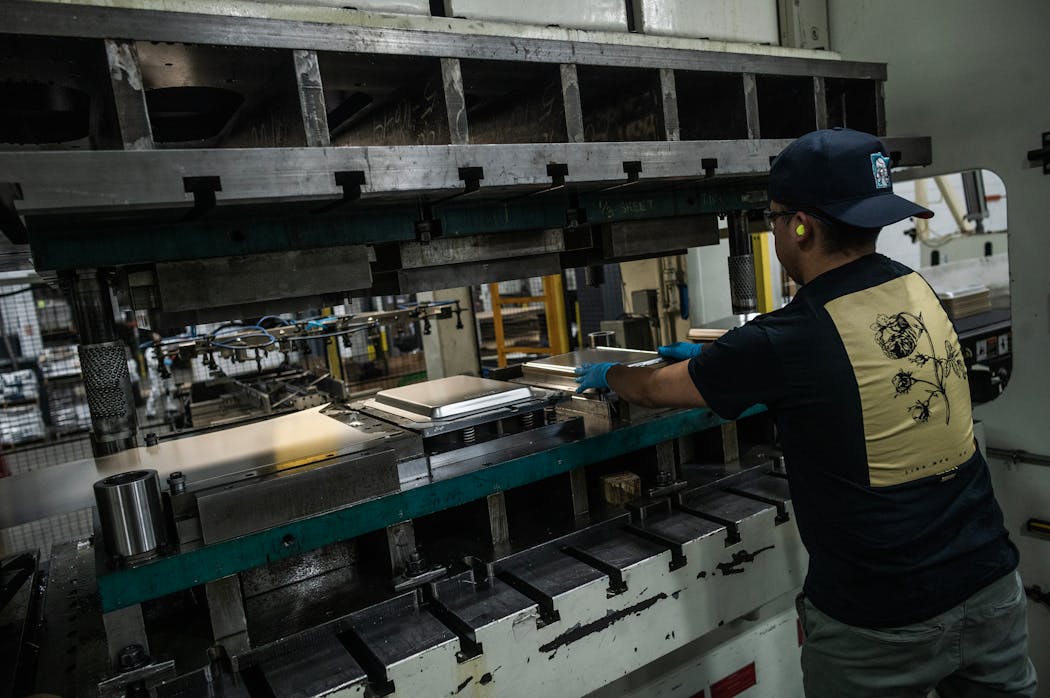Over the past two years, 3M sold nearly 25,000 different products that contain PFAS, the "forever chemicals" that will soon be largely illegal in Minnesota.
While the company has reformulated nearly one-third of those products — mostly sandpaper and tape that didn't use much to begin with — 3M expects to lose out on more than $1 billion in annual sales as it phases out PFAS production by the end of next year.
Even as regulations and litigation drive PFAS toward extinction, there are no replacements for all its uses. Companies are sprinting to find suitable substitutions in thousands of consumer products, including dental floss and raincoats, that rely on the highly functional chemicals.
"Safe, economically-feasible alternatives are not there; they're not readily available," said Allison Lange Garrison, a product liability and complex litigation attorney at Nilan Johnson Lewis. "So to say PFAS could simply be swapped out — that's a really tall order."
Per- and polyfluoroalkyl substances are a family of chemicals pioneered by 3M that have shaped modern life over the past 70 years. Consumer products rely on PFAS to make items waterproof, stain-resistant, flame-retardant, non-stick, lubricated and heat-transferring. PFAS is used to help mold plastics, etch semiconductor chips and smother dangerous fuel fires.
Those advances, while functional and convenient, have come at a great cost to the environment and human health. The properties that make PFAS chemicals so useful — nearly unbreakable molecular bonds — cause them to linger in the environment indefinitely, and in human blood streams for years. A growing body of scientific research has linked the chemicals with some cancers, developmental problems and reduced immune response.
"We lived for thousands of years without this stuff. Do we need it?" said Susan Richardson, a University of South Carolina scientist who has studied PFAS for decades. "Maybe new products won't be quite as great as products with PFAS. But I've got faith in the smart chemists out there that they'll come up with something that's not harmful to people and the environment."
The clock is ticking, as Minnesota next year will ban intentionally added PFAS in 11 product categories, including carpeting, cosmetics, cleaning products and cookware. That's in addition to a ban on PFAS in food containers that went into effect last month. By 2032, nearly all PFAS uses will be outlawed in the state. There are some exceptions, especially in medical devices, where PFAS will be allowed indefinitely.
Minnesota's PFAS policy is called Amara's Law, after Amara Strande, one of many east metro residents who for years unknowingly drank water contaminated with PFAS chemicals that were dumped near a 3M plant.
Strande died from a rare form of liver cancer last year, and spent her final months advocating for the ban.
Where to find PFAS
One of the most recognizable uses of PFAS is on nonstick pans — the chemicals help scrambled eggs or seared steaks slip smoothly off cooking surfaces. But the cookware industry was already preparing to shift to new coatings, said David Dalquist, chief executive of Minneapolis-based Nordic Ware, the cookware maker.
California already requires bakeware and cookware brands to report if they use several different chemicals, including some types of PFAS. It's made consumers more aware of the materials coating their kitchen tools.
"We said look, we're going to have to make changes here," Dalquist said. "Let's get out ahead of this thing."
Minneapolis-based Target had a similar idea when it pledged in 2017 to get PFAS out of textiles by 2022. The retailer missed that goal and is now aiming for a 2025 deadline, the same as Minnesota's law, to remove PFAS from "owned brand products including but not limited to textiles, formulated, cosmetics, beauty and cookware items," according to the company's sustainability report.
At Nordic Ware's factory in St. Louis Park, the company stamps giant aluminum sheets into jelly roll pans, injects polypropylene plastic into molds that become cupcake trays, and sprays nonstick coatings on a slow-moving assembly line of twirling cake pans.
The company's trademarked Bundt cake molds and some other products never contained PFAS. But the PFAS formulation PTFE, often sold as Teflon, has been used for stovetop cookware, helping release proteins from the cooking surface, according to Jennifer Dalquist, David's daughter and the company's head of marketing.
Nordic Ware is now aiming to remove PFAS from all operations by the end of March, and it has launched two lines of stovetop pans without them. But some retailers have been hesitant to accept the new ceramic-coated products, Jennifer Dalquist said, since earlier versions were infamous for chipping and flaking.
"You show them something that we're proud to put our name on, and they're like, 'Hmm, I'm not sure we're ready for that yet,' " she added.
A risky business
Many industries facing PFAS bans in Minnesota are already well aware of greater scrutiny on the chemicals, said Tom Johnson, the Minnesota Pollution Control Agency's government relations director.
"This is happening at a nationwide and a global scale," he said. "Shareholders are concerned about liability with PFAS."
By May 2025, the U.S. Environmental Protection Agency is requiring manufacturers to take inventory of all the PFAS in their products, processes and supply chains as the federal agency moves toward stricter regulation. Several countries in Europe have proposed near-total PFAS restrictions, and the European Union might be just a few years away from a continent-wide ban, Lange Garrison said.
Last year, 3M agreed to pay $6 billion to settle PFAS claims brought by municipal water suppliers, which are now struggling to filter the chemicals out of water supplies. The company could face another $10 billion to $30 billion in other PFAS liabilities down the road, analysts predict.
With or without a ban, PFAS is looking toxic from a business perspective.
"Notwithstanding how difficult and painful this is — that you'll be diverting R+D dollars away from innovation to evolving your supply chain — there's a business case to be made for switching," Lange Garrison said. "The time is now to get that process started."
3M says the hunt for alternatives is ongoing, and researchers have developed "a new technology that can be used to manufacture certain tapes that are used in a wide variety of automotive, aerospace, consumer and construction applications," the company told the Star Tribune.
Where there aren't alternatives or feasible innovations, there will be tradeoffs in what products can offer — and how much they cost.
That may be the case with new firefighting foam that Richardson, the University of South Carolina scientist, will be studying for the U.S. Navy to ensure they are PFAS-free.
She said the PFAS-based foam is "superior to anything out there, especially for fuel fires, and it saves a lot of lives," and the same goes for firefighter protective gear enhanced with PFAS.
"Maybe these new firefighting foams are almost as good, or good enough."
Health, safety and society
Some exceptions to Minnesota's PFAS ban are written into the law, such as medical devices regulated by the Food and Drug Administration.
But industry groups argue that some uses can never be replaced.
"The 21st century economy is pretty much reliant on PFAS compounds in one fashion or another," said Kevin Fay of the Sustainable PFAS Action Network, or SPAN.
The group was founded by Honeywell and Intel. Semiconductor chips, which power most modern electronic devices, are made using PFAS chemicals — sometimes including 3M products, like Novec fluid.
"The chemistry is a critical part of the etching process for the chips," Fay said. "It's what allows them to put billions of nodes onto a chip in those small sizes."
The MPCA will write a rule over the next few years to exempt other PFAS uses that, in the words of state law, are essential to "health, safety or the functioning of society." The agency is asking the public now how it should structure this new rule. Johnson declined to comment on whether semiconductor chips or any other product might be a candidate for a future exemption.
By 2032, those "unavoidable uses" will be the only ones allowed in Minnesota.
SPAN, meanwhile, wants a federal rule to bring more uniformity to how the chemicals can be used across the country, one that would group the chemicals based on health risk, how they behave and how easily they escape into the environment, Fay said.
There are some differences — fluoropolymers are essentially high-performance plastics, and make up products like bands for the Apple Watch. Surfactants, like the legacy PFAS formulations PFOA and PFOS, were more commonly used as coatings, and continue to be found all over the planet, even though the manufacture of some has been phased out in the United States.
But in Minnesota, the definition of PFAS written into the law is intentionally broad, Johnson said. Just one carbon-fluorine bond in a molecule subjects it to the state's regulation.
"It's based on sort of the opposite look," Johnson said. "What is essential? And everything else falls away."

Minnesota Department of Health rescinds health worker layoffs

Eco-friendly house on 30 acres near Marine on St. Croix listed at $1.6M

DOGE cuts federal money for upgrades at Velveeta plant in New Ulm





